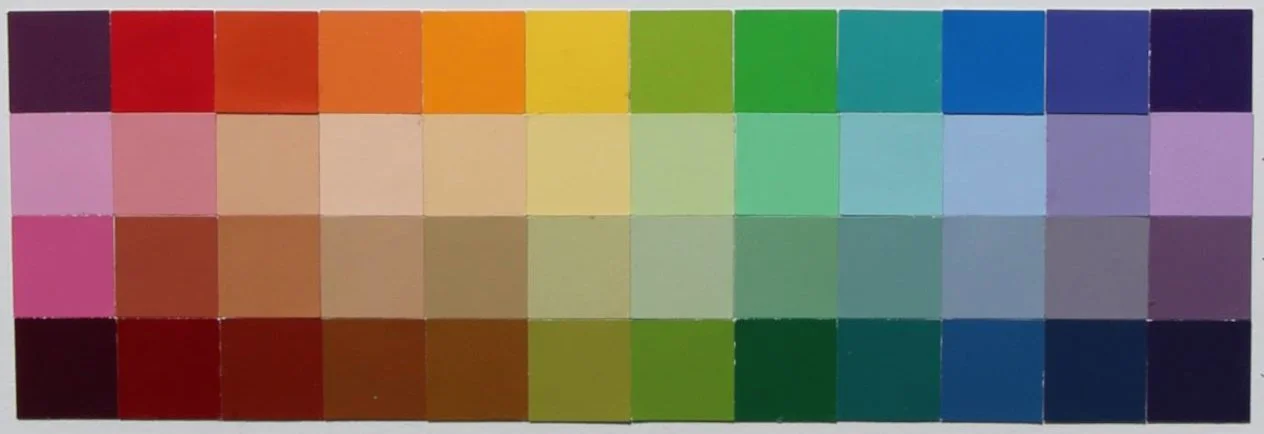Composition & Design
WORK IN PROGRESS
Preface: composition seems to the average person, elusive and mystical, although visual composition is not much different from language or music. In its simplest form, composition is selection, by the artist, of objects and elements that convey his interpretation into the material form
VALUE: relative degree of lightness and darkness
COLOR: Light of different wavelengths
Hue: Color in itself;
Value: Tints and Shades of a hue;
Saturation: Intensity of a hue;
TEXTURE: Surface Quality - Can be actual or implied.
LINE: Is a continuous mark on a surface or is implied by the edges of shapes and forms
SHAPE: Is a flat enclosed area created through line, value, or texture. It can also be an area enclosed by other shapes. This is called a negative shape.
GEOMETRIC SHAPE: Are all precisely edged and mathematically curved.
ORGANIC SHAPE. Are free form, unpredictable and flowing.
FORM: Refers to a 3-dimensional volume. When represented on a two dimensional surface it involves perspective, lighting, and shading. Like shapes, forms can be either geometric or organic.
PERSPECTIVE: Creates the illusion of space on a 2-dimensional surface.
ATOMOSPHERIC PERSPECTIVE: The observed phenomenon of objects shifting hue, losing saturation and opacity, more and more as they fall further into the distanced horizon
PROPORTION: Describes the relationship between quantities. Dimension refers to measured width and height of an area. Ratio is the proportional relationship between width and height. Proportion applies to elements within a composition quantitatively (i.e. Proportion of light and dark), or are used to evaluate form (i.e. rule of thirds, golden ratio)
THE GOLDEN RATIO: Is indicated by 1:1.618 and is often called “The divine proportion.” The value of 1.618 is called phi φ, which is equal to (1+√5)/2
SPACE AND PROPORTION: Centered 1:1 / Rule of Thirds 1:1:1 / Golden Ratio 1.618BALANCE: Arrangement of objects as it relates to their visual weight in a composition based on our ideas of physical structure (mass, gravity, sides of composition).
RADIAL SYMMETRY: Built equally around a central point.
SYMMETRY: Also Known as formal balance. Even distribution of weight around a central, vertical, or horizontal axis. Visually identical forms on both sides. If forms are similar, but not identical, it is called approximate symmetry.
ASYMMETRY: Also known as informal balance. No even distribution around the central axis. Objects of different sizes are arranged so they balance one another with their visual weight. Often one dominant form is offset by multiple smaller forms. Greater sense of visual tension.
RHYTHM: Patterned Movement indicated by the regular succession of motifs in a composition, or of opposite or different elements.
BY REPETITION: Involves the use of a pattern to create a usual beat.
BY ALTERNATION: A sequence of alternating motifs.BY GRADATION: Employs a series of motifs patterned to relate to one another through a regular progression of steps.
LINEAR RHYTHM: Refers to a characteristic of flow of an individual line or a brush stroke.
EMPHASIS: Special stress or importance. Sometimes called dominance. Provides a focal point for the composition.
BY CONTRANST: Elements stand out because of differences in either size, value, hue, saturation, texture, shape, or direction.
BY ISOLATION: If most objects are grouped together, an object by itself stands out.
BY PLACEMENT: An object place in the center (or golden section will often be perceived as a focal point. The same is true of all eyes in a work are looking at one point or if an object is place at a vanishing point.
UNITY: The relationship between individual parts and the whole of the composition. Stems from the Gestalt theories of visual perception and psychology of how the brain organizes visual information into categories or groups.
BY PROXIMITY: Grouping objects closely together.
BY CONTINUATION: In the direction of the eye through the composition/ -Using strong directional lines. -Continuation of line, edge, or direction from one area to another. -Through uninterrupted flow, overlapping, or touching.
UNITY BY REPETITION: A design element is repeated in various parts of the composition to relate them to eachother.
INUTY BY CLOSURE: Missing information is filled in with the brain.

